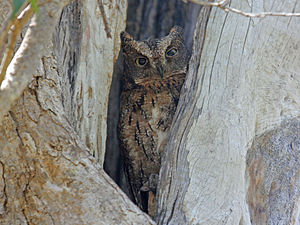Madagascar scops owl
| Madagascar scops owl | ||||||||||
|---|---|---|---|---|---|---|---|---|---|---|

Madagascar scops owl |
||||||||||
| Systematics | ||||||||||
|
||||||||||
| Scientific name | ||||||||||
| Otus rutilus | ||||||||||
| ( Pucheran , 1849) |
The Madagascar scops owl ( Otus rutilus ) is a kind of the scops owls (genus Otus ) within the real owls (Strigidae). She lives in Madagascar . It was first described by Jacques Pucheran in 1849.
features
The Madagascar scops reach a size of 19 to 23 centimeters and a weight of up to 120 grams, whereby the females are usually a little heavier. It comes in three color types, a brown, a reddish (especially in the eastern part of Madagascar) and a gray-brown (especially in the western part of the island). All forms have relatively small tufts of ears, a yellow iris , a gray-brown belly and toes as well as black-brown claws. The face is light brown with dark brows, the back plumage is interspersed with yellow and white spots and often with a black pattern. There are white areas with black markings in the shoulder area. The ventral side of all forms is more or less gray-brown with red-brown and black stripes.
distribution and habitat
The Madagascar scops owl is common throughout the island of Madagascar. The Mayotte scops owl ( Otus mayottensis ) on the Comoros island of Mayotte was long considered a subspecies Otus rutilus mayottensis . The Madagascar scops owl is not considered endangered by the IUCN .
The owls prefer moist forests and bushland, in the west also drier areas with isolated trees.
Way of life
The Madagascar scops owl feeds mainly on large insects , mainly beetles and moths . She hunts them both in flight and in the trees and on the ground.
Very little is known about the reproduction of the animals. They are probably mostly cave-nesters in tree hollows, although ground nests are also known. The clutch consists of three to four eggs that the female hatches.
Etymology and history of research
Jacques Pucheran described the owl under the name Scops rutilus . The type specimen for the description came from Madagascar. Only later was it added to the genus Otus, which was introduced by Thomas Pennant in 1769 for the Indian scops owl ( Otus bakkamoena ) . This is derived from the Greek "ōtos ωτος " for "ear owl". The specific epithet »rutilus« is the Latin word for »golden, red, red-brown«.
literature
- James A. Jobling: Helm Dictionary of Scientific Bird Names . Christopher Helm, London 2010, ISBN 978-1-4081-2501-4 .
- Jacques Pucheran: Observation sur les types peu connus du Musée de Paris . In: Revue et magasin de zoologie pure et appliquée (= 2 ). tape 1 , 1849, p. 17–29 ( online [accessed December 19, 2014]).
- Thomas Pennant: Indian Zoology . 1st edition. NA, London 1769 ( online [accessed December 19, 2014]).
Individual evidence
- ↑ Otus rutilus in the endangered Red List species the IUCN 2012. Posted by: BirdLife International, 2012. Accessed October 29, 2012th
- ↑ Jacques Pucheran, p. 29 (footnote belongs to the article).
- ↑ Thomas Pennant, p. 3, plate 3.
- ↑ James A. Jobling, p. 286.
- ↑ James A. Jobling, p. 344.
Web links
- Otus rutilus inthe IUCN 2014 Red List of Threatened Species . 3. Listed by: BirdLife International, 2012. Retrieved November 30, 2014.
- BirdLife International: Species Factsheet - Madagascar Scops-owl ( Otus rutilus ) . Retrieved November 30, 2014.
- Videos, photos and sound recordings of Madagascar Scops-owl (Otus rutilus) in the Internet Bird Collection
- Island owl ( Otus rutilus ) at Avibase; Retrieved November 30, 2014.
- Otus rutilus in the Integrated Taxonomic Information System (ITIS)
- xeno-canto: Sound recordings - Madagascar Scops-owl ( Otus rutilus )
- Kind on the Owlpages